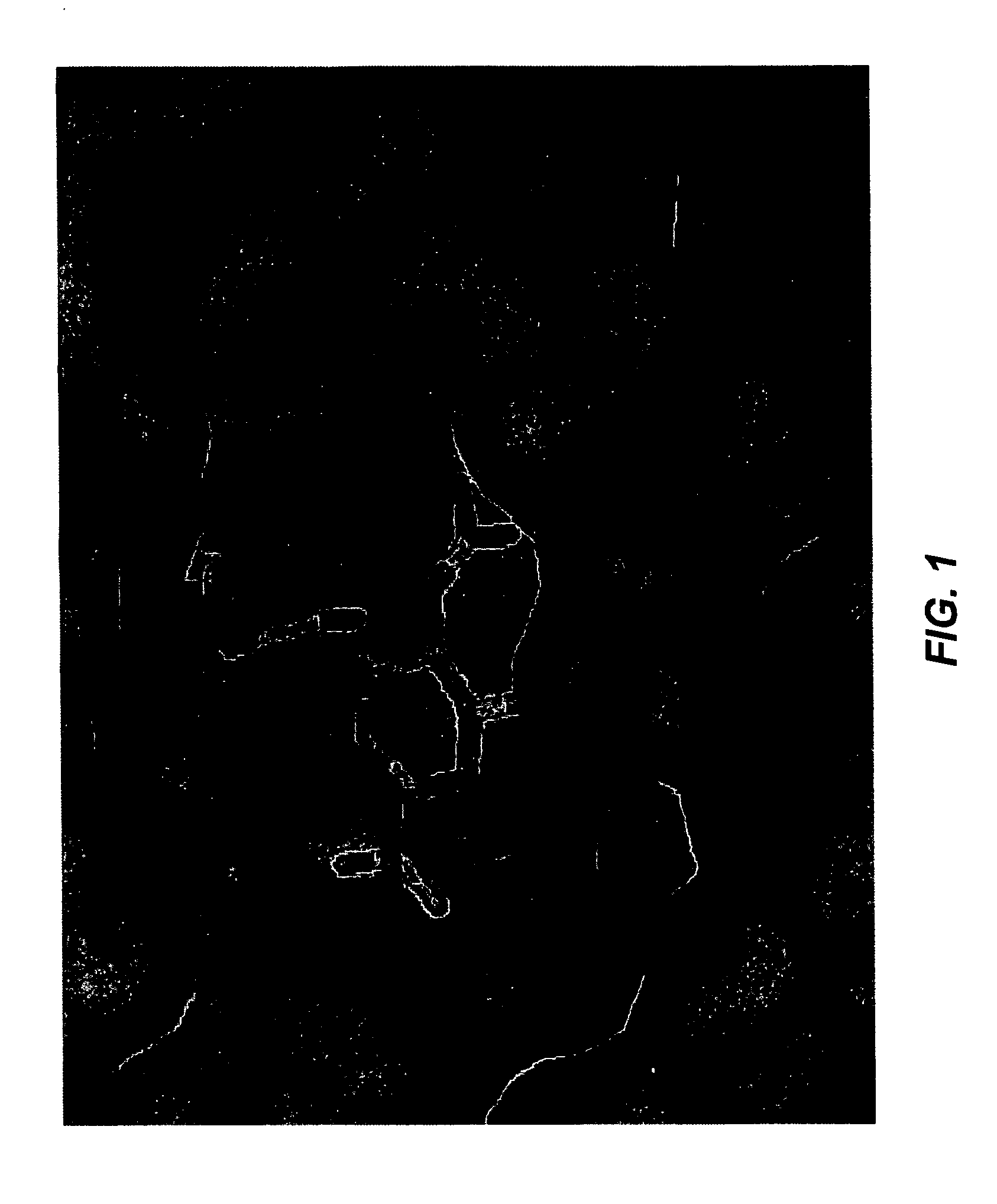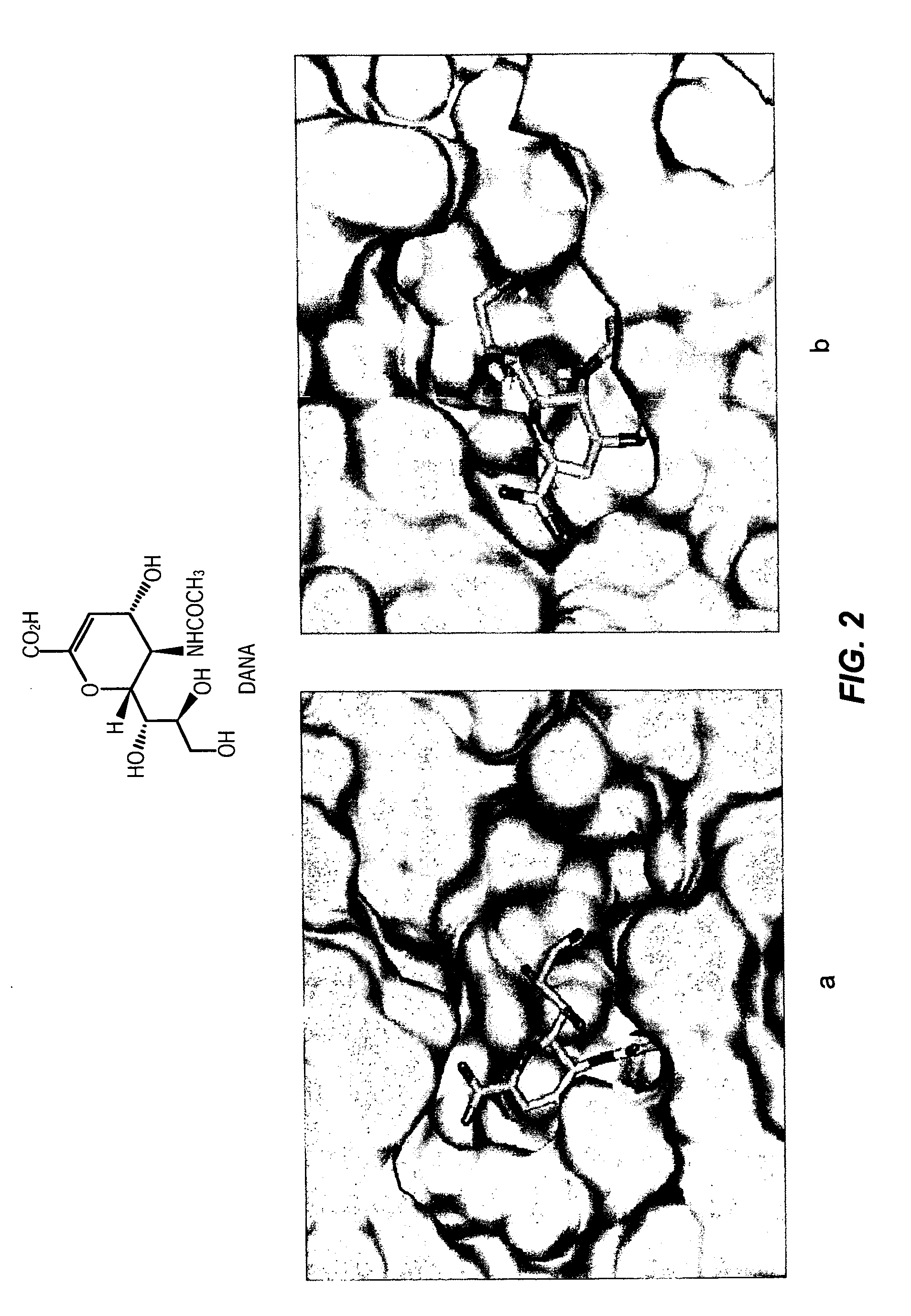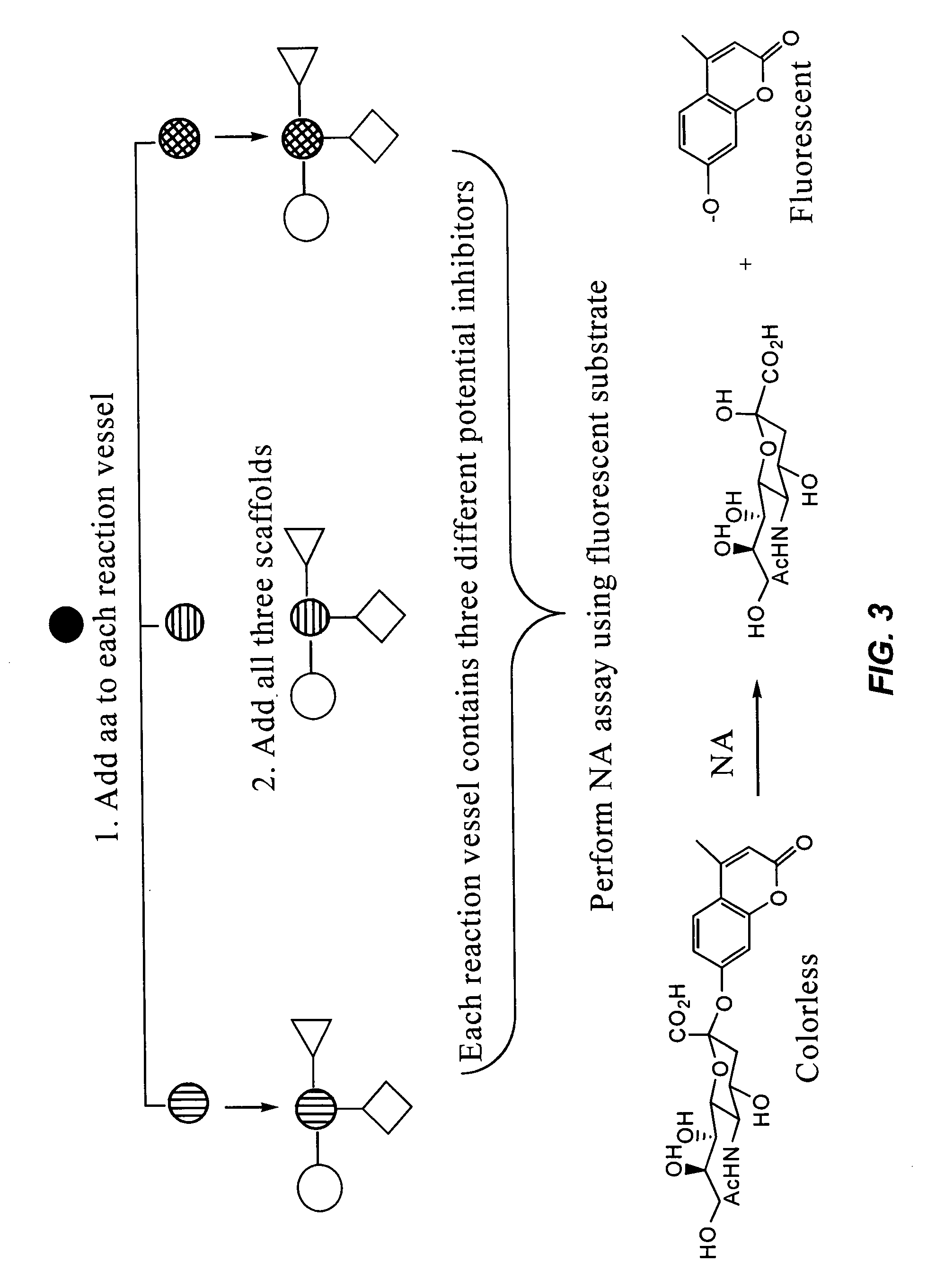Labeled substrate conjugates for identifying enzyme inhibitors
- Summary
- Abstract
- Description
- Claims
- Application Information
AI Technical Summary
Benefits of technology
Problems solved by technology
Method used
Image
Examples
example 1
Synthesis of Detectable Label-Substrate Conjugate 8-Allyl-4-methylumbelliferyl-4,7,8,9-tetra-O-acetyl-α-D-N-acetyl-neuraminic amide-bead conjugate
7-Allyloxy-4-methylcoumarin (2)
[0084]
[0085] 3-Bromo-1-propene (2.95 mL, 34.06 mmol) was added dropwise under argon to a stirred mixture of 7-hydroxy-4-methylcoumarin 1 (2.0 g, 11.35 mmol) and anhydrous potassium carbonate (K2CO3) (2.35 g, 17.03 mmol) in acetone (50 mL). The resulting mixture was then refluxed for 4 h, after which it was allowed to cool, and the K2CO3 filtered off and washed with fresh acetone. The solvent was removed in vacuo and the residue was crystallized from methanol to afford 2 as white-cream crystals (2.36 g, 96%). TLC (hexane / ethyl acetate, 1:3): Rf=0.63. mp 110° C. 1H NMR (CDCl3, 500 MHz) δ 2.39 (s, 3H, CH3), 4.60 (d, J=5.0 Hz, 2H, CH2), 5.33 (d, J=10.5 Hz, 1H), 5.44 (d, J=17.5 Hz, 1H), 6.05 (m, 1H), 6.12 (s, 1H), 6.80 (s, 1H), 6.87 (dd, J=1.5, 9.0 Hz, 1H), 7.49 (d, J=9.0 Hz, 1H). 13C NMR (CDCl3, 125 MHz) δ 18.7...
example 2
Synthesis of Detectable Label-Substrate Conjugate 4-Methyl acetate-umbelliferyl-4,7,8,9-tetra-O-acetyl-α-D-N-acetyl-neuraminic amide-bead conjugate
4-Bromomethyl-7-hydroxycoumarin (7)
[0089]
[0090] NaOMe (5.38 mL, 0.5 M, 2.69 mmol) was added slowly under argon to a stirred solution of 4-bromomethyl-7-acetoxycoumarin 6 (0.80 g, 2.69 mmol) in dry methanol (15 mL). The resulting mixture was stirred for 0.5 h. The methanolic solution was acidified with Dowex 50WX8 (H+) resin, filtered, washed with methanol, and evaporated to afford 7 as a white solid (0.68 g, 100%). TLC (hexane / ethyl acetate, 1:3): Rf=0.58. mp 207° C. 1H NMR (CD3OD, 500 MHz) δ 4.66 (s, 2H, CH2), 6.36 (s, 1H, C═CH), 6.73 (d, J=1.5 Hz, 1H), 6.84 (dd, J=1.5, 8.5 Hz, 1H), 7.71 (d, J=8.5 Hz, 1H). 13C NMR (CD3OD, 125 MHz) δ 27.58, 103.80, 111.17, 112.32, 114.37, 127.54, 153.61, 157.23, 163.24, 163.28. ESIMS calcd for C10H8BrO3 [M+H]+ 255.0, found 255.1.
4-Bromomethylumbelliferyl-4,7,8,9-tetra-O-acetyl-α-D-N-acetyl-neuraminic a...
example 3
Synthesis of Detectable Label-Substrate Conjugate 4-Sodium acetate-umbelliferyl-α-D-N-acetyl-neuraminic amide-bead conjugate
4-Methyl acetate-umbelliferyl-4,7,8,9-tetra-O-acetyl-α-D-N-acetyl-neuraminic acid methyl ester (13)
[0094] 2-Deoxy-2-chloro-4,7,8,9-tetra-O-acetyl-α-D-N-acetyl-neuraminic acid methyl ester (1.10 g, 2.12 mmol) was dissolved in a mixture of 12 (see Zhu, Q. et al. Organic Lett. 2003, 5, 1257-1260). (0.54 g, 2.33 mmol), Ag2CO3 (0.58 g, 2.12 mmol) and activated molecular sieves (1.8 g) in anhydrous acetonitrile (30 mL). The mixture was stirred under argon at room temperature in the dark for 24 h, filtered, and evaporated. The residue was purified by column chromatography (ethyl acetate) to give 13 as pale yellow solid (0.66 g, 44%). TLC (ethyl acetate): Rf=0.18. mp 105° C. [α]D26+25.6° (c 0.5, CHCl3). 1H NMR (CDCl3, 500 MHz) δ 1.92, 2.04, 2.14 (3s, 15H, 4-OAc, 1-NAc), 2.25 (m, 1H, H-3a), 2.72 (dd, J=4.5, 13.0 Hz, 1H, H-3e), 3.70 (s, 3H, CO2CH3), 3.74 (s, 3H, CO2CH3...
PUM
| Property | Measurement | Unit |
|---|---|---|
| Molar density | aaaaa | aaaaa |
| Molar density | aaaaa | aaaaa |
| Molar density | aaaaa | aaaaa |
Abstract
Description
Claims
Application Information
 Login to View More
Login to View More - R&D
- Intellectual Property
- Life Sciences
- Materials
- Tech Scout
- Unparalleled Data Quality
- Higher Quality Content
- 60% Fewer Hallucinations
Browse by: Latest US Patents, China's latest patents, Technical Efficacy Thesaurus, Application Domain, Technology Topic, Popular Technical Reports.
© 2025 PatSnap. All rights reserved.Legal|Privacy policy|Modern Slavery Act Transparency Statement|Sitemap|About US| Contact US: help@patsnap.com



